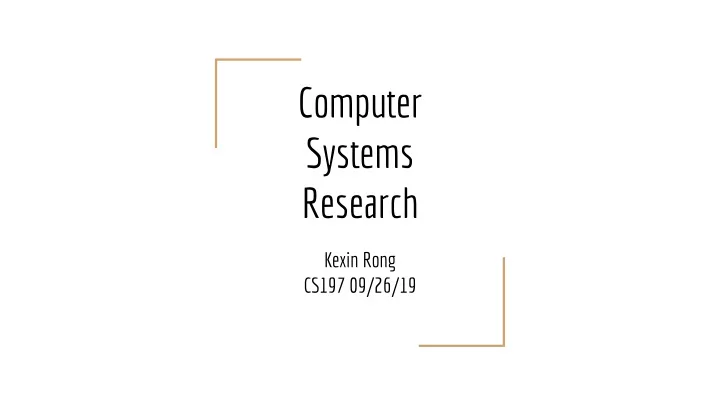

Computer Systems Research Kexin Rong CS197 09/26/19
Agenda - Area overview - Introductions - Project overview - (maybe git tutorial)
What is a computer system? - Software and hardware systems - A system comprises of many components - Components need to interact and cooperate well to provide the overall behaviour - Components typically have well specified interfaces - Key goals in systems: - Performance/Scalability - Reliability/Availability - Usability/Generality - Security
Some famous systems contributions
Systems Area Overview A non-exhaustive list of the subareas in systems: - Architecture - Networking - Security - Distributed Systems - Databases - Operating Systems
Distributed Systems Example : Resilient Distributed Datasets: A Fault-Tolerant Abstraction for ● In-Memory Cluster Computing Problem : Frameworks such as MapReduce do not handle applications ● like iterative algorithms and interactive data mining tools efficiently, which reuse intermediate results across multiple computations. Idea : Keeping data in memory can greatly improve performances of such ● applications. RDD is an abstraction that is general enough to support a range of applications and can also provide fault tolerance efficiently. Evaluation : ● Speedups on K-means, Logistics Regression, PageRank versus Hadoop: ○ Fault recovery ○ User applications ○
Architecture Example : In-Datacenter Performance Analysis of a Tensor Processing Unit ● Problem : How to design a specialized hardware to improve the ● cost-energy-performance of neural network inferences? Idea : Matrix Multiply Unit designed for dense matrices. The philosophy of ● the TPU microarchitecture is to keep the matrix unit busy. Evaluation : ● Roofline analysis against CPUs and GPUs ○ Alternative TPU designs ○
Networking Example : A Buffer-Based Approach to Rate Adaptation: Evidence from a Large ● Video Streaming Service Problem : How to dynamically choose the video bit rates to: ● 1) maximizes the video quality by picking the highest video rate the network can support ○ 2) minimize rebuffering events which halts the video if the client’s playback buffer goes empty. ○ Idea : Choose the video rate based ● only on the playback buffer occupancy. Evaluation : Reduced the rebuffer ● rate by 10–20% compared to Netflix’s then-default ABR algorithm.
Security/Database Example : ACIDRain: Concurrency-Related Attacks on Database-Backed Web ● Applications Attack : Adversaries can exploit race condition to e.g. double spend vouchers. ● Defense: Use database logs to reconstruct transaction history, and detect ● cycles as potential anomaly Evaluation : Demonstrated vulnerabilities in 50% eCommerce site ●
Database Example : C-Store: A Column-oriented DBMS ● Problem : Row-oriented databases are optimized for writes but not for ● reads Idea: Storage of data by column rather than by row ● Evaluation : Performance comparison on a number of queries ●
Introductions!
It’s your turn! Name Year Fun fact What brings you here? Anything else you’d like to share
Assignment 1 - due nexu Wednesday! Part 1: Read a paper and write an outline ● Part 2: Starter Task ● Set up a Google cloud instance ○ Email instructions on how to request credits to follow ■ Play with git ○ Reproduce a benchmark ○ Produce a plot ○ Please enroll in the correct session!! (My OH: Monday 9-10am @ Gates 433 )
#1 Independence Assumption in Real Life CORDS: Automatic Discovery of Correlations and Soft Functional Dependencies P[Make = “Honda”] = 1/7 P[Model = “Accord”] = 1/8 P[Make = “Honda” & Model = “Accord”] = ?
#2 Answering Queries with Metadata Implementing Data Cubes Efficiently *Focus on main ideas, you don’t need to understand the proofs.
#3 Designing Sketches in End-to-end Systems Ray: A Distributed Framework for Emerging AI Applications Also check out their project website for resources: Code: https://github.com/ray-project/ray Documentation: http://ray.readthedocs.io/en/latest/index.h tml Tutorial: https://github.com/ray-project/tutorial Blog: https://ray-project.github.io
#4 Sketches for Interactive Visualization Systems Hillview: A trillion-cell spreadsheet for big data
#5 Hash Table Bake off A Seven-Dimensional Analysis of Hashing Methods and its Implications on Query Processing
git branching
git rebase
Local versus remoue
Recommend
More recommend